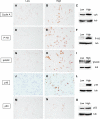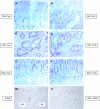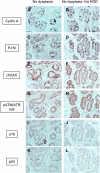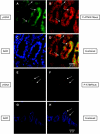Evidence for DNA damage checkpoint activation in barrett esophagus
- PMID: 20165693
- PMCID: PMC2822452
- DOI: 10.1593/tlo.09187
Evidence for DNA damage checkpoint activation in barrett esophagus
Abstract
Barrett esophagus is an epithelial metaplasia that predisposes to adenocarcinoma. Better markers of cancer risk are urgently needed to identify those patients who are likely to benefit most from emerging methods of endoscopic ablation. Disease progression is associated with genomic DNA changes (segmental gains, losses, or loss of heterozygosity). Although these changes are not easily assayed directly, we hypothesized that the underlying DNA damage should activate a DNA damage response (DDR), detectable by immunohistochemical (IHC) assays of checkpoint proteins and the resulting replicative phase cell cycle delays. Surgical specimens and endoscopic biopsies (N = 28) were subjected to IHC for the cell cycle markers cyclin A and phosphorylated histone H3 (P-H3), the DDR markers gammaH2AX and phosphorylated ATM/ATR substrates (P-ATM/ATRsub), and the DNA damage-responsive tumor suppressors p16 and p53. Correlations were made with histologic diagnoses. The fractions of cells that stained for cyclin A, P-H3, and gammaH2AX increased in parallel in dysplastic tissue, consistent with checkpoint-mediated cell cycle delays. Foci of nuclear gammaH2AX and P-ATM/ATRsub were demonstrated by standard and confocal immunofluorescence. Staining for p16 was more prevalent in early-stage disease with lower staining for gammaH2AX and P-H3. Staining for p53 was moderately increased in some early-stage disease and strongly increased in some advanced disease, consistent with checkpoint-mediated induction and mutational inactivation of p53, respectively. We suggest that IHC for DDR-associated markers may help stratify risk of disease progression in Barrett.
Figures






References
-
- Winters C, Jr, Spurling TJ, Chobanian SJ, Curtis DJ, Esposito RL, Hacker JF, III, Johnson DA, Cruess DF, Cotelingam JD, Gurney MS, et al. Barrett's esophagus. A prevalent, occult complication of gastroesophageal reflux disease. Gastroenterology. 1987;92:118–124. - PubMed
-
- Drewitz DJ, Sampliner RE, Garewal HS. The incidence of adenocarcinoma in Barrett's esophagus: a prospective study of 170 patients followed 4.8 years. Am J Gastroenterol. 1997;92:212–215. - PubMed
-
- Dulai GS, Shekelle PG, Jensen DM, Spiegel BM, Chen J, Oh D, Kahn KL. Dysplasia and risk of further neoplastic progression in a regional Veterans Administration Barrett's cohort. Am J Gastroenterol. 2005;100:775–783. - PubMed
-
- Lagergren J, Bergstrom R, Lindgren A, Nyren O. Symptomatic gastroesophageal reflux as a risk factor for esophageal adenocarcinoma. N Engl J Med. 1999;340:825–831. - PubMed
-
- Spechler SJ. Dysplasia in Barrett's esophagus: limitations of current management strategies. Am J Gastroenterol. 2005;100:927–935. - PubMed
Grants and funding
LinkOut - more resources
Full Text Sources
Research Materials
Miscellaneous
